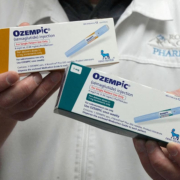Novo’s Saxenda effectively, safely lowers BMI in children: NEJM study
Novo’s Saxenda effectively, safely lowers BMI in children: NEJM study
Novo Nordisk’s weight-loss therapy Saxenda (liraglutide) can help children aged six to 12 years of age manage their weight, according to a study published Tuesday in The New England Journal of Medicine.
The Phase IIIa study, which was supported by Novo Nordisk, enrolled 82 patients who were given either Saxenda or placebo and found that the GLP-1 treatment helped stave off weight gain when used with lifestyle adjustments. At 56 weeks, body weight increased by 1.6% in children in the Saxenda arm, as opposed to 10% in placebo counterparts. The treatment effect—a reduction of 8.4 percentage points in favor of Saxenda—was statistically significant with a p-value of 0.001.
Body mass index (BMI), the study’s primary outcome, dropped by 5.8% on average in Saxenda patients, whereas placebo comparators saw a 1.6% increase. The overall effect also satisfied statistical significance, with a p-value less than 0.001.
In terms of safety, adverse events were common but balanced between the Saxenda and placebo treatment groups. However, gastrointestinal toxicities were more common among patients on Novo’s weight-loss treatment. Serious side effects arose in 12% of Saxenda-treated children and in 8% of placebo counterparts.
Lead author Claudia Fox, of the Center for Pediatric Obesity Medicine, University of Minnesota Medical School, in a statement called obesity “the most common chronic disease of childhood” and noted that patients have limited treatment options outside of lifestyle changes.
Liraglutide was approved by the FDA in 2014 to help adults lose weight and in 2020 the regulator extended the approval to children ages 12 to 17.
Timely and early intervention for childhood obesity is “critical,” Fox said. “Left untreated, obesity in childhood almost universally persists into adulthood and is associated with significant ill health, including diabetes and cardiovascular disease, and for some, premature death.”










